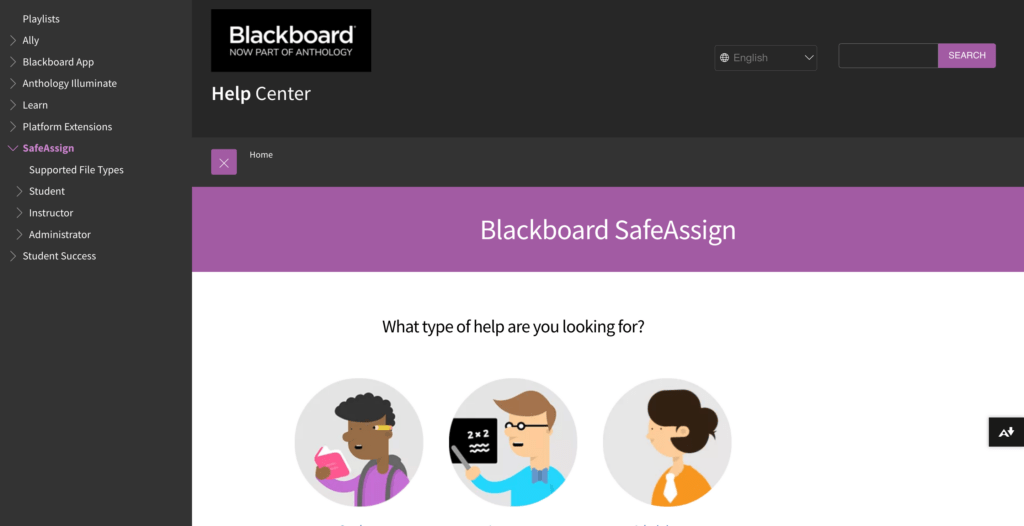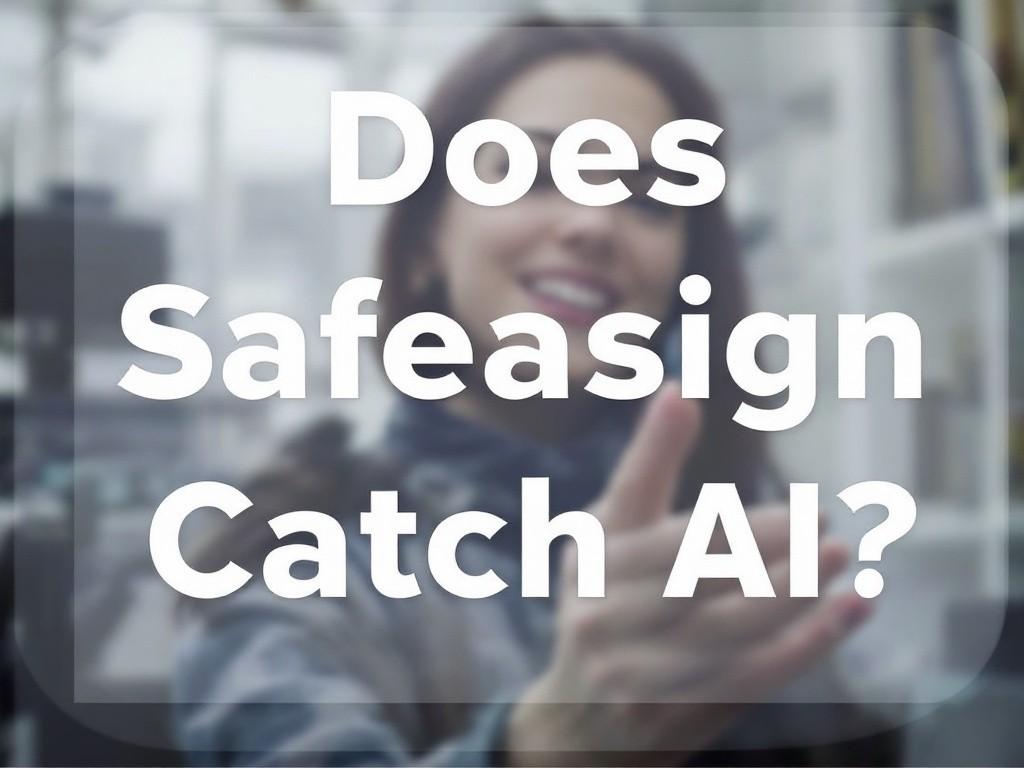When AI started getting a bit advanced, students began fleeing in droves to look for any kind of AI writing tool assistance-including ChatGPT-to help them with their assignments.
The net result brings into question the aspect of academic integrity and how the plagiarism detection software in Blackboard, known as SafeAssign, works.
The discussion in this article will be focused on Does Safeassign Catch AI-generated content and possible ways around it.
What is SafeAssign?
SafeAssign is a plagiarism detection tool that is part of the Blackboard learning management system (LMS). It helps educators ensure the originality of student submissions by comparing them against a vast database of existing materials, including previously submitted work, academic papers, and online sources. By generating a similarity score, SafeAssign assists instructors in identifying potential instances of plagiarism.

How SafeAssign Works
To answer ‘Does SafeAssign detect ChatGPT?’, we first need to understand how SafeAssign works. SafeAssign scans documents for text matches and highlights sections that may have been copied from other sources. It relies on several databases, including:
- Institutional Document Archives: Contains papers submitted by users in their respective institutions. This helps prevent students from submitting work that has already been evaluated.
- Global Reference Database: Includes over 59 million papers volunteered by students to prevent cross-institutional plagiarism. This database is crucial for identifying similarities across different educational institutions.
- ProQuest ABI/Inform Journal Database: Comprises more than 3,000 publication titles and 5 million documents. This resource allows SafeAssign to check academic journals and articles for potential matches.
- Internet Sources: Searches the broader internet for matching text. This feature enables SafeAssign to identify content that may be freely available online.
While SafeAssign is effective at detecting traditional plagiarism, its ability to identify AI-generated content remains a topic of discussion among educators and students alike.
Does Safeassign Catch AI?
The short answer is no; SafeAssign is not specifically designed to detect AI-generated content. Since AI tools like ChatGPT produce original text based on patterns rather than copying existing material, SafeAssign struggles to recognize it as plagiarized. Instead, it focuses on matching text against its databases.

Key Factors in Detection Limitations
- Originality of AI Text: AI-generated content is often unique and does not directly copy existing texts. Instead of replicating phrases or sentences verbatim, AI tools generate new combinations of words based on learned patterns from a vast range of data. This makes it difficult for traditional plagiarism detection tools like SafeAssign to flag it as copied material.
- Writing Style Differences: The conversational tone typical of AI-generated text may not align with the formal academic writing style expected in assignments. For instance, AI-generated content might use simpler sentence structures or more casual language than what is typically required in scholarly work. This stylistic difference can lead to inconsistencies that may be noticeable to instructors but not necessarily flagged by SafeAssign.
- Lack of Citations: AI outputs often lack proper citations, which can raise flags in academic writing but may not be detected as plagiarism by SafeAssign. In academic contexts, failing to cite sources appropriately can lead to accusations of plagiarism, even if the content itself is original. Students using AI-generated text should be aware of this risk and ensure they provide proper attribution where necessary.
- Evolving Detection Algorithms: As technology advances, so do the methods used by detection tools like SafeAssign. While current iterations may struggle with identifying AI-generated text, future updates could incorporate more sophisticated algorithms that analyze writing patterns beyond simple text matching.
This brings us back to our initial question: Does blackboard have ai detection? The factors above suggest that traditional plagiarism detection tools face significant challenges in identifying AI-generated content.
FAQs
Can Blackboard detect the use of AI?
Blackboard itself does not have built-in capabilities to detect AI-generated content directly. However, it integrates with tools like Turnitin, which has developed features aimed at identifying patterns indicative of AI writing. These features analyze submissions for linguistic markers that may suggest machine authorship, providing instructors with additional insights into the originality of student work.
Is ChatGPT detectable on SafeAssign?
No, SafeAssign does not have specific mechanisms to detect content generated by ChatGPT or similar AI tools. Its primary function is to identify copied material from existing sources rather than analyze the originality or authorship of the text itself.
Does SafeAssign detect AI?
SafeAssign does not currently detect AI-generated text. It primarily focuses on identifying instances of plagiarism by comparing submissions against its extensive databases. Therefore, if a student submits work generated by an AI tool without any direct copying from other sources, it is unlikely to be flagged as problematic.
Does Blackboard have AI detection?
While Blackboard does not natively include AI detection features, it has partnered with Turnitin, which offers some capabilities for identifying AI-generated content based on specific markers. These markers may include unusual phrasing or patterns that deviate from typical human writing styles.
Can Blackboard detect ChatGPT?
Blackboard cannot directly detect ChatGPT-generated content. However, if integrated with Turnitin’s advanced features, it may flag certain patterns or unusual phrasing that could suggest AI involvement. Instructors may then choose to investigate further based on these flags.
Can Blackboard detect AI?
Similar to the previous answers, Blackboard does not have direct detection capabilities for AI-generated content but relies on integrated tools like Turnitin for this purpose. As these tools evolve, they may become more adept at recognizing characteristics associated with machine-generated writing.
Does SafeAssign catch ChatGPT?
No, SafeAssign does not catch ChatGPT-generated content due to its reliance on matching existing texts rather than analyzing writing style or originality. Students using ChatGPT should still be cautious about how they present their work and consider revising any generated content significantly before submission.
Does Blackboard detect ChatGPT?
Blackboard itself does not detect ChatGPT outputs directly but may flag them if they exhibit characteristics recognizable by integrated tools like Turnitin. Instructors familiar with student writing styles may also notice discrepancies that prompt them to question the authenticity of a submission.
Strategies to Avoid Detection
If you choose to use AI tools like ChatGPT for your assignments, consider these strategies to minimize the risk of detection:
- Edit and Revise: After generating text using an AI tool, thoroughly edit and revise the content to match your personal writing style and voice. This includes changing sentence structures, vocabulary choices, and overall tone to make the work feel more authentic.
- Add Citations: If you use information or ideas generated by an AI tool, ensure you cite them appropriately according to your institution’s guidelines. Proper citations not only enhance credibility but also help avoid potential accusations of academic dishonesty.
- Combine Sources: Use the AI-generated text as a starting point but combine it with your research and insights to create original content. Integrating your own analysis or perspective can enrich the assignment while reducing the likelihood of detection by plagiarism software.
- Understand Academic Integrity Policies: Familiarize yourself with your institution’s policies regarding the use of AI in academic work to avoid unintentional violations. Knowing what constitutes acceptable use can help you navigate potential pitfalls when incorporating technology into your studies.
- Use as a Brainstorming Tool: Leverage AI for brainstorming ideas rather than relying solely on it for complete assignments. Generating outlines or exploring different angles on a topic can provide valuable inspiration while ensuring that your final submission reflects your individual thinking.
- Seek Feedback from Peers: Before submitting your work, consider sharing it with classmates or friends for feedback. They can provide insights into how well your writing aligns with expectations and whether any sections feel disjointed or out of place.
Final Thoughts
In other words, SafeAssign is a powerful tool in traditional plagiarism detection within the Blackboard ecosystem; it does not, however, have the capacity to detect the content generated by advanced AI models such as ChatGPT. And with changes in technology and education, the tools developed to support academic integrity will need to change as well.
Knowing how these systems work and incorporating responsible writing practices within the Blackboard environment, such as editing generated content and properly citing sources, will allow you to navigate some of the challenges AI presents in the academic setting.
Continue to be aware of the detection methods and use AI responsibly to maintain originality in your work as you realize the benefits of technology in your writing process without compromising academic integrity.
